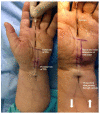Early Postoperative Recovery after Modified Ultra-Minimally Invasive Sonography-Guided Thread Carpal Tunnel Release
- PMID: 37108996
- PMCID: PMC10145732
- DOI: 10.3390/jpm13040610
Early Postoperative Recovery after Modified Ultra-Minimally Invasive Sonography-Guided Thread Carpal Tunnel Release
Abstract
Thread carpal tunnel release (TCTR) has been reported to be safe and effective for the treatment of carpal tunnel syndrome. The aim of this study is to evaluate the modified TCTR for safety, efficacy, and postoperative recovery. Seventy-six extremities in 67 patients undergoing TCTR were analyzed pre- and postoperatively using clinical parameters and patient-reported outcome measures. Twenty-nine men and 38 women with a mean age of 59.9 ± 18.9 years underwent TCTR. The mean postoperative time to resume activities of daily living was 5.5 ± 5.5 days, analgesia was completed after 3.7 ± 4.6 days, and return to work was achieved after a mean of 32.6 ± 15.6 days for blue-collar workers and 4.6 ± 4.3 days for white-collar workers. The Boston Carpal Tunnel Questionnaire (BCTQ) and Disability of Arm, Shoulder, and Hand (DASH) scores were comparable with previous studies. Overall, two persistent compressions and one recurrence required open reoperation (3.9%). All three had been operated in the initial phase, and none required reoperation after an additional safety step was introduced. No other complications occurred. TCTR surgery appears to be a safe and reliable technique with almost no wound and scarring and a potentially faster recovery time than open techniques. Although our technical modifications may reduce the risk of incomplete release, TCTR requires both ultrasound and surgical skills and has a considerable learning curve.
Keywords: carpal tunnel syndrome; minimally invasive; percutaneous; sonography; thread release; ultra-minimally invasive; ultrasound.
Conflict of interest statement
The authors declare no conflict of interest.
Figures






Similar articles
-
Long-Term Outcomes of Ultrasound-Guided Thread Carpal Tunnel Release and Its Clinical Effectiveness in Severe Carpal Tunnel Syndrome: A Retrospective Cohort Study.J Clin Med. 2024 Jan 2;13(1):262. doi: 10.3390/jcm13010262. J Clin Med. 2024. PMID: 38202268 Free PMC article.
-
A Controlled Trial Evaluating the Safety and Effectiveness of Ultrasound-Guided Looped Thread Carpal Tunnel Release.Hand (N Y). 2021 Jan;16(1):73-80. doi: 10.1177/1558944719842199. Epub 2019 Apr 15. Hand (N Y). 2021. PMID: 30983412 Free PMC article. Clinical Trial.
-
A Clinical Study of the Modified Thread Carpal Tunnel Release.Hand (N Y). 2017 Sep;12(5):453-460. doi: 10.1177/1558944716668831. Epub 2016 Sep 12. Hand (N Y). 2017. PMID: 28832215 Free PMC article.
-
Minimally invasive ultrasound-guided thread carpal tunnel release: a video demonstration protocol.J Ultrasound. 2025 Mar 6. doi: 10.1007/s40477-025-01003-0. Online ahead of print. J Ultrasound. 2025. PMID: 40048109 Review.
-
Percutaneous Sonographically Guided Release of Carpal Tunnel and Trigger Finger: Biomechanics, Clinical Results, Technical Developments.Hand Clin. 2022 Feb;38(1):91-100. doi: 10.1016/j.hcl.2021.08.010. Hand Clin. 2022. PMID: 34802613 Review.
Cited by
-
Long-Term Outcomes of Ultrasound-Guided Thread Carpal Tunnel Release and Its Clinical Effectiveness in Severe Carpal Tunnel Syndrome: A Retrospective Cohort Study.J Clin Med. 2024 Jan 2;13(1):262. doi: 10.3390/jcm13010262. J Clin Med. 2024. PMID: 38202268 Free PMC article.
-
A cadaveric study of ultrasound guided nonincisional trigger finger release with newly developed threads.Sci Rep. 2025 Jul 2;15(1):23532. doi: 10.1038/s41598-025-08847-w. Sci Rep. 2025. PMID: 40604046 Free PMC article.
-
The Promise of Personalized Peripheral Nerve Surgery.J Pers Med. 2024 Jun 7;14(6):608. doi: 10.3390/jpm14060608. J Pers Med. 2024. PMID: 38929829 Free PMC article.
-
Ultrasound-guided minimally invasive thread release of carpal tunnel: a cadaveric study.Radiol Med. 2025 Apr;130(4):524-533. doi: 10.1007/s11547-025-01952-w. Epub 2025 Jan 21. Radiol Med. 2025. PMID: 39836344 Free PMC article.
-
Hybrid-J shape needle in ultrasound-guided looped thread carpal tunnel release: a cadaveric study on safety and efficacy.BMC Musculoskelet Disord. 2025 Jul 28;26(1):721. doi: 10.1186/s12891-025-08932-1. BMC Musculoskelet Disord. 2025. PMID: 40721769 Free PMC article.
References
-
- Salaffi F., De Angelis R., Grassi W. Prevalence of musculoskeletal conditions in an Italian population sample: Results of a regional community-based study. I. The MAPPING study. Clin. Exp. Rheumatol. 2005;23:819–828. - PubMed
LinkOut - more resources
Full Text Sources

